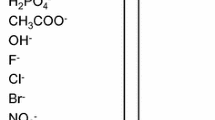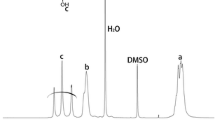Abstract
Near-infrared absorption spectra obtained for aqueous solutions of eight aprotic organic compounds at concentrations up to 10% molar fraction were analyzed in detail using principal component analysis to determine the variation in the hydrogen-bonded network of water upon dissolution of the compounds. The shape of the overtone band of the O–H stretching mode, which is a sensitive indicator of the condition of the hydrogen-bonded network, was observed to vary with concentration and temperature. Principal component analyses revealed that all observed spectral variations consisted mainly of two components. The first component was similar to that observed for pure water upon a temperature change. The second component contributed to an increase in absorption intensity in the lower frequency region upon dissolution of any organic compound. This observation supports a model that involves the dissolution of an aprotic compound that generates ice-like aggregates of water molecules in the solution. In contrast, the contribution of the first component depends on the type of solute and its concentration; the first component contributes either to strengthening of the hydrogen-bonded network (similar to the change upon a temperature decrease) or to weaken it (similar to the change upon a temperature increase).






Similar content being viewed by others
References
Tôrres, R.B., Marchiore, A.C.M., Volpe, P.L.O.: Volumetric properties of binary mixtures of (water + organic solvents) at temperatures between T = 288.15 K and T = 303.15 K at p = 0.1 MPa. J. Chem. Thermodyn. 38, 526–541 (2006)
Checoni, R.F., Volpe, P.L.O.: Measurements of the molar heat capacities and excess molar heat capacities for water + organic solvents mixtures at 288.15 K to 303.15 K and atmospheric pressure. J. Solution Chem. 39, 259–276 (2010)
Marcus, Y.: Water structure enhancement in water-rich binary solvent mixtures. J. Mol. Liq. 158, 23–26 (2011)
Marcus, Y.: Water structure enhancement in water-rich binary solvent mixtures. Part II. The excess partial molar heat capacity of the water. J. Mol. Liq. 166, 62–66 (2012)
Uchida, N., Yoshimura, N., Takayanagi, M.: Variation of the near-infrared spectrum of water from dissolved salts. J. Solution Chem. 44, 2167–2178 (2015)
Lawton, W.H., Sylvestre, E.A.: Self modeling curve resolution. Technometrics 13, 617–633 (1971)
Czarnik-Matusewicz, B., Pilorz, S., Hawranek, J.P.: Temperature-dependent water structural transitions examined by near-IR and mid-IR spectra analyzed by multivariate curve resolution and two-dimensional correlation spectroscopy. Anal. Chim. Acta 544, 15–25 (2005)
Jung, Y.M., Czarnik-Matusewicz, B., Kim, S.B.: Characterization of concentration-dependent infrared spectral variations of urea aqueous solutions by principal component analysis and two-dimensional correlation spectroscopy. J. Phys. Chem. B 108, 13008–13014 (2004)
Shimoaka, T., Hasegawa, T.: Molecular structural analysis of hydrated ethylene glycol accounting for the antifreeze effect by using infrared attenuated total reflection spectroscopy. J. Mol. Liq. 223, 621–627 (2016)
Shao, X., Cui, X., Liu, Y., Xia, Z., Cai, W.: Understanding the molecular interaction in solutions by chemometric resolution of near-infrared spectra. Chem. Select 2, 10027–10032 (2017)
Pestova, O.N., Efimov, A.Y., Myund, L.A., Kudrev, A.G., Khripun, V.D., Davidian, A.G., Baranauskaite, V.E.: Structural inhomogeneity in electrolyte solutions: the calcium perchlorate–water system. J. Solution Chem. 46, 1854–1870 (2017)
Németh, Z.I., Rákosa, R.: Detectability of concentration-dependent factors by application of PCA. An indicator curve for the determination of important principal components and a post-correction for transformation of principal components to factors. J. Chemom. 32(4), e2998 (2018)
Grundy, W.M., Schmitt, B.: The temperature-dependent near-infrared absorption spectrum of hexagonal ice. J. Geophys. Res. 103, 25809–25822 (1998)
Mastrapa, R.M.E., Brown, R.H.: Ion irradiation of crystalline H2O-ice: effect on the 1.65-μm band. Icarus 183, 207–214 (2006)
Franks, F., Ives, J.G.: The structural properties of alcohol–water mixtures. Quart. Rev. 20, 1–44 (1966)
Onori, G., Santucci, A.: Dynamical and structural properties of water/alcohol mixtures. J. Mol. Liq. 69, 161–181 (1996)
D’Angelo, M., Onori, G., Santucci, A.: Self-association of monohydric alcohols in water: compressibility and infrared absorption measurements. J. Chem. Phys. 100, 3107–3113 (1994)
Koga, Y.: Excess partial molar enthalpies of tert-butanol in water–tert-butanol mixtures. Can. J. Chem. 66, 1187–1193 (1988)
Yoshida, K., Kitajo, A., Yamaguchi, T.: 17O NMR relaxation study of dynamics of water molecules in aqueous mixtures of methanol, ethanol, and 1-propanol over a temperature range of 283–403 K. J. Mol. Liq. 125, 158–163 (2006)
Funding
This study was funded solely by Tokyo University of Agriculture and Technology.
Author information
Authors and Affiliations
Corresponding author
Ethics declarations
Conflict of interest
The authors declare that they have no conflict of interest.
Rights and permissions
About this article
Cite this article
Katsu, S., Yoshimura, N. & Takayanagi, M. Variation in the Liquid Structure of Water Upon Dissolution of Aprotic Polar Organic Compounds as Studied by Near-Infrared Spectroscopy. J Solution Chem 47, 1202–1213 (2018). https://doi.org/10.1007/s10953-018-0784-2
Received:
Accepted:
Published:
Issue Date:
DOI: https://doi.org/10.1007/s10953-018-0784-2




